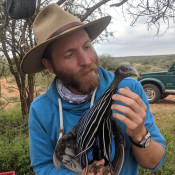<< See all events
The costs of collective behaviour
Collective behaviours are fundamental to group-living. Research over the past two decades has revealed a myriad of ways that animal groups benefit from making collective decisions. However, much less is known about the costs that participating in collective decision-making entails. Drawing from studies on vulturine guineafowl, a large and terrestrial bird species endemic to east Africa, I will show that groups make collective decisions through a voting-like process, but that collective actions also induce distinct costs. These costs range from the energetic cost of movement through to physiological stress experienced by birds as they attempt to influence the behaviour of their group. These costs then raise the question of why animals live in groups, especially in the vulturine guineafowl that forms a multilevel society where sets of groups interact with one-another. The answer to this question can be found in the severe drought that struck Kenya from 2020 to 2023, during which time we could see a clear survival benefit arise for birds that expressed a multilevel social structure. Together, these studies on vulturine guineafowl highlight how sociality is a fine and constantly changing balance of the costs of being in a group versus the benefits that group-living can provide, and that these can arise at different timescales.

Dr. Damien Farine
Department of Evolutionary Biology and Environmental Studies, University of Zurich, Switzerland